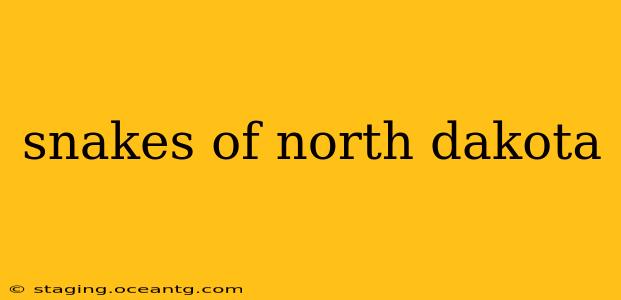North Dakota, while known for its expansive prairies and rugged badlands, also harbors a fascinating array of snake species. Understanding these reptiles, their habitats, and their role in the ecosystem is crucial for responsible coexistence. This guide explores the snakes you might encounter in North Dakota, addressing common questions and dispelling myths.
What types of snakes live in North Dakota?
North Dakota's snake population is relatively small compared to more southern states. However, several species call the state home. These include both venomous and non-venomous snakes, each with its unique characteristics and preferred habitats. The most commonly encountered include:
- Eastern Massasauga Rattlesnake ( Sistrurus catenatus): This is the only venomous snake found in North Dakota. It's a relatively small rattlesnake, typically shy and non-aggressive, preferring wetland areas.
- Plains Garter Snake (Thamnophis radix): A common and widespread non-venomous snake, easily identified by its distinctive three stripes. They're often found near water sources.
- Western Fox Snake (Pantherophis vulpinus): A large, non-venomous snake often mistaken for a rattlesnake due to its similar coloring and behavior. However, it lacks rattles.
- Bullsnake (Pituophis catenifer): Another large, non-venomous snake known for its docile nature and constricting abilities. They are often found in grasslands and prairies.
- Northern Red-bellied Snake (Storeria occipitomaculata): A small, slender snake easily recognized by its red belly. They are harmless and usually found under rocks and logs.
Are there poisonous snakes in North Dakota?
Yes, the Eastern Massasauga Rattlesnake is the only venomous snake species found in North Dakota. While venomous, it's generally not aggressive and will only bite if provoked or cornered. It's crucial to maintain a safe distance and avoid handling any snake you encounter, especially those with rattles.
What is the most common snake in North Dakota?
The Plains Garter Snake is likely the most common snake in North Dakota due to its wide distribution and adaptability to various habitats. Their abundance contributes significantly to the ecosystem's balance.
How many different types of snakes are there in North Dakota?
While the exact number can fluctuate slightly depending on surveys and sightings, North Dakota has a relatively small number of snake species compared to states with warmer climates. The species listed above represent the majority of those found within the state.
What should I do if I see a snake in North Dakota?
If you encounter a snake in North Dakota, the best course of action is to:
- Observe from a safe distance: Admire the snake without approaching or attempting to handle it.
- Identify the snake (if possible): Consult field guides or online resources to identify the species. This can help determine whether it is venomous.
- Give it space: Snakes are often more afraid of you than you are of them. Allow them to retreat to their natural habitat.
- Never try to handle a snake: This applies to both venomous and non-venomous snakes. A bite, even from a non-venomous snake, can be painful and lead to infection.
- If bitten by a venomous snake, seek immediate medical attention: Call emergency services and remain calm.
Understanding the snakes of North Dakota allows for respectful coexistence and appreciation of their vital role in the state's biodiversity. Remember, these creatures are an essential part of the ecosystem, and responsible observation is key to ensuring their continued presence.
